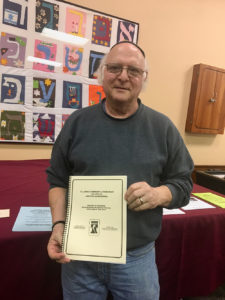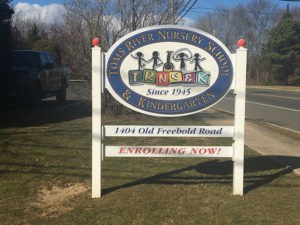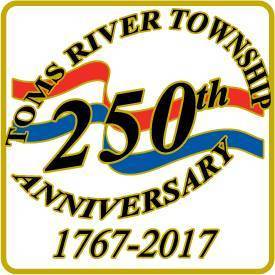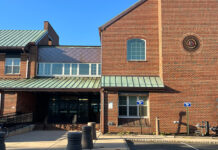
TOMS RIVER – With a population of 91,000 and 42 square miles that span from the ocean to the pinelands, Toms River Township is one of the largest municipalities in the county. But what might not be so obvious is the impact that Jewish immigrants had in shaping the area in the mid-20th century.

Members of the Congregation B’Nai Israel hosted a presentation of Toms River history given by Township Clerk and Historian Mark Mutter. The event was held in preparation of the town’s upcoming 250th anniversary on June 24.
By a show of hands, most congregates in the room were not born in Toms River, but emigrated to the area in the 1940s, 50s, 60s and primarily the 70s. The Congregation B’Nai Israel itself has been serving the local Jewish community since 1950.
One of the congregation’s oldest members is Eta Estomin, who at 94 years old was one of the parents who helped establish the town’s first nursery school back in 1945.
Although it has changed locations a few times, the Toms River Nursery School on Old Freehold Road is still in operation today.
History From Jewish Residents

In 1976, Rabbi Richard Hammerman of Congregation B’nai Israel had the idea for some of the older congregates to write a history of their emigration into Toms River and share what it was like growing up.
It took almost a year for members of the Ocean County Historical Society to translate and reprint the handwritten stories of those 30 or 40 Jewish families that first settled in town. The transcript is now available for purchase at the historical society on Hadley Avenue.
“If you’re interested in the history of this congregation and history of Jews in Toms River, this is one to pick up,” said Robert Foxman, vice president of the Ocean County Historical Society. “It is some beautiful reading.”
One congregate produced his wife’s reunion flyer for the Toms River Class of 1945. He questioned the acceptance of immigrants at that time, telling Mutter that she was deemed a foreigner by her principal and struggled to fit in because she wasn’t a “Clayton or an Applegate.”

Still, the Jewish settlers contributed to neighborhoods throughout what is now Pleasant Plains, Silverton and North Dover neighborhoods, owning dairy or chicken farms in those areas of town.
Many came here fleeing WWII and Nazi persecution.
Mutter remembered the site of an old chicken farm maintained by early Jewish settlers escaping persecution. The land was converted into a girls’ softball field complex on North Bay Avenue a few years ago.
Mutter noted that Jewish girls growing up in the 20th century may not have had the same opportunity to play on those fields because of racism at the time.
“I’ve made many talks and I’ve written many articles,” said Mutter, “But I only have one that’s framed in town hall and it’s the talk that I gave when we dedicated that softball field and remembered your legacy, of your grandparents and your parents.”
Earlier History
Toms River as a town dates back even before the United States was formed. Toms River broke free from Shrewsbury Township to become its own municipality in 1767, a full nine years before the Declaration of Independence. Mutter outlined much of this early history as well in his presentation to Congregation B’nai Israel.
The original settlers were the Lenni Lenape Indians. These indigenous people left behind the town and river names we still know today, such as Metedeconk, Hackensack, Manahawkin and Passaic.
Barnegat Bay got its name from English explorer Henry Hudson, when he spotted a great lake of water while sailing with the Dutch East India Company in 1609. He referred to the area as barandegat, which means “where the waters break.”
And in 1685 Englishman Thomas Luker married the Lenni Lenape Cheiftan’s daughter and they settled in modern day downtown behind the post office. Early maps of the area bared the name Tom’s River, before the apostrophe slowly faded into time.
Changing Times, Changing Name
 Residents eventually petitioned the royal assembly to make the area its own municipality, claiming that Shrewsbury Township was too big and made it difficult to supervise roads and provide for the poor. When the petition was finally approved five months later, the area was named Dover Township, which remained the town’s legal name for over 200 years.
Residents eventually petitioned the royal assembly to make the area its own municipality, claiming that Shrewsbury Township was too big and made it difficult to supervise roads and provide for the poor. When the petition was finally approved five months later, the area was named Dover Township, which remained the town’s legal name for over 200 years.
When residents were asked to vote on an official name change to Toms River in 2006, the entire clerk’s office was opposed to the change because they assumed it would be costly and confusing for businesses. Mutter also feared that it would mean losing hundreds of years of history.
In addition to this historical discussion, the township is planning a series of historical events over the next few months as part of the semiquincentennial anniversary, including a World War I commemoration, artifact exhibition and historic mural display made by high school students.
“More important than having a party, we want to have a history and civics lesson, particularly for the young people in our community to know our town’s history,” said Mutter. “If we remember the past we can do good things in the future.”






